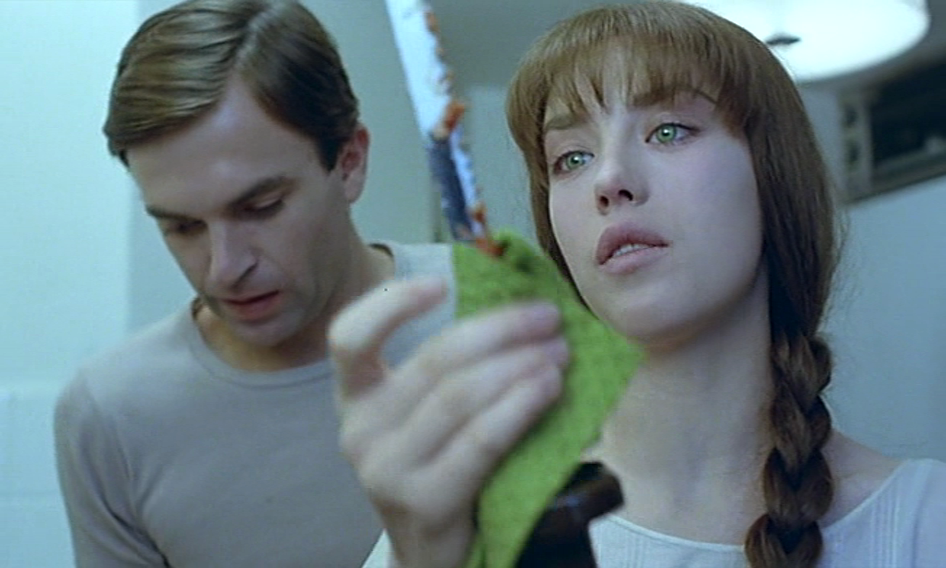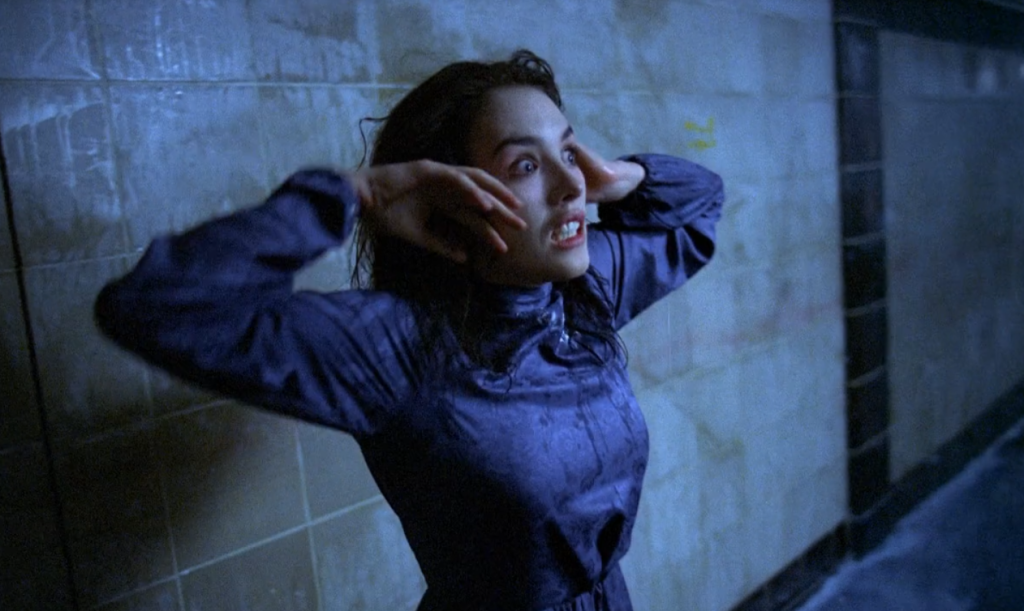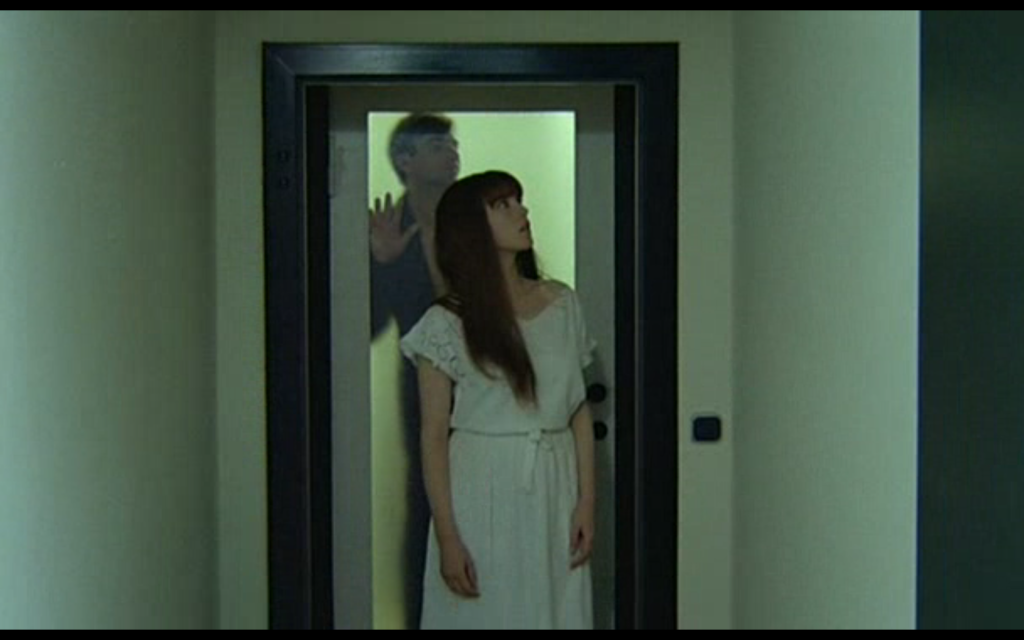This January, in support of the Toronto Rape Crisis Centre / Multicultural Women Against Rape, friends and family have raised over $1,000, which means I have to watch and write about thirty-one horror movies. I’ll watch (on average) one movie a night, many of them requested by donors, after which I’ll write some things about said movies on this website. Be forewarned that all such write-ups will contain spoilers! Last night, I watched the only horror movie this month that I’d seen once before: the impressive It Follows, directed by David Robert Mitchell (The Myth of the American Sleepover). Good friend Marielle Pawson donated a generous amount to this fundraiser on behalf of her mother. I previously watched The Exorcist III on her mother’s behalf, but Marielle’s real wish was to watch It Follows with friends. See, Marielle was really curious about last year’s indie hit It Follows, but was afraid to watch it on her own. A joint screening with Marielle and Meg was arranged. I rented a copy of It Follows from my friends at Queen Video, who were very excited about my rental.
What happens:
It Follows, which – spoiler alert – is one of the better new horror movies I’ve seen in years, opens with some spooky Carpenter-esque music and a quiet suburban American street. (We find out later this is set in the suburbs of Detroit.) A teenage girls runs out of a house in her pyjamas and heels, looking haunted. The neighbour loading groceries asks if she needs help, which she refuses. Then her dad goes to the door and asks what the matter is. She again says she’s fine, and runs back into her house. A few seconds later, however, she rushes back out of the house, into her car, and speeds off. When we next see her, she’s at the beach in the dead of night, seated with her back to the water. The headlights of the car illuminate her as she calls her dad on a cell phone, expresses her love for him, then apologizes for being a brat sometimes.
The film smash cuts to the beach on the morning. The girl is now dead, her leg broken backward and body contorted in a disturbing manner.
We are then introduced to our protagonist, college-aged Jay (Maika Monroe), who lounges in the aboveground pool at her parents’ home. Her sister, Kelly (Lili Sepe), arrives home, and calls Jay inside. Kelly watches some ’50s B-movies with their family friends: the slightly awkward Paul (Keir Gilchrist), and bespectacled Yara (Olivia Luccardi), who always seems to have her nose in her clamshell-shaped e-reader. She’s reading Dostoyevsky’s The Idiot, but has yet to determine if it’s any good. (Stay tuned, literature fans!) Jay goes upstairs to prepare for her date with a new guy she’s been seeing, Hugh (Jake Weary).
Jay goes to the movies with Hugh, who looks a bit like a dime-store Pacey from Dawson’s Creek. While waiting in line, she tells him about “the trade game” she used to play with her sister, where you choose one person in a crowd you’d like to trade places with, and other people have to try to guess who you chose. When they play, Jay is perplexed by Hugh’s choice, a small boy at the movies with his parents. Hugh looks wistful and expresses envy that the boy has his whole life ahead of him. “You’re only twenty-one,” Jay says. Taking their seats, Hugh tries to guess her choice. “The girl in the yellow dress?” he guesses. But Jay has no idea who he’s talking about; she can’t see any girl in a yellow dress. Hugh makes them leave the theatre immediately, saying he feels ill and needs to be outside. Jay, however, worries he spotted a past girlfriend.
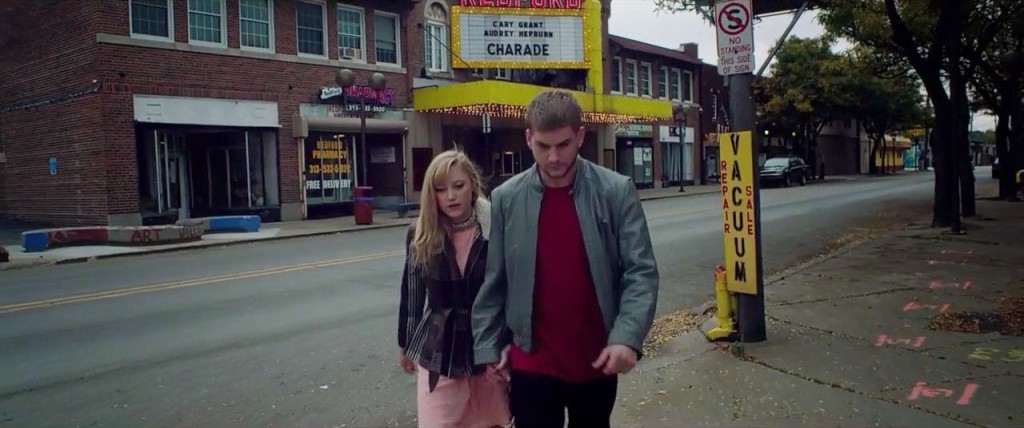
The real question is which of the couple’s lives does the marquee’s title refer to?
Kelly and Jay walk through their neighbourhood, talking about Hugh, and we learn that Jay and Hugh have yet to sleep together. Across the street from Jay and Kelly’s house, we see local cool dude Greg (Daniel Zovatto), a Jeremy London type washing his car in his driveway. Hugh and Jay go on another date, taking some beer to the water, then adjoining to his car’s backseat to make love for the first time in an abandoned parking lot. Afterwards, Hugh goes to his trunk while Jay spreads out on the backseat and reminisces about what her concept of dating was like when she was younger. Hugh then slides up behind Jay and presses a chloroformed cloth to her face, rendering her unconscious. (The rendering takes way longer than almost any other movie featuring chloroform, so I’m going to assume it’s more realistic.)
Jay wakes up bound to a wheelchair that’s been placed in an abandoned aboveground parking garage. Hugh appears behind her and apologizes, assuring her he won’t hurt her. That’s the good news. The bad news is that he’s “given” her something – something someone gave to him through sex and now he’s given it to her. A thing will follow her, and it could look like anyone – someone she knows well or a total stranger. “Sometimes I think it looks like people you love, just to hurt you,” he says. Hugh sees something approaching, so he wheels Jay in her chair to the edge of the garage, where they can see a naked woman slowly climbing up the hill. This, he hopes, will demonstrate that what he is saying is true. Hugh advises Jay sleep with someone as soon as possible to pass it along. For if she is killed by the thing, it will come for him next, then all the way down the line. He offers some advice on avoiding it: never enter a room with only one exit. “It’s very slow, but it’s not dumb.”
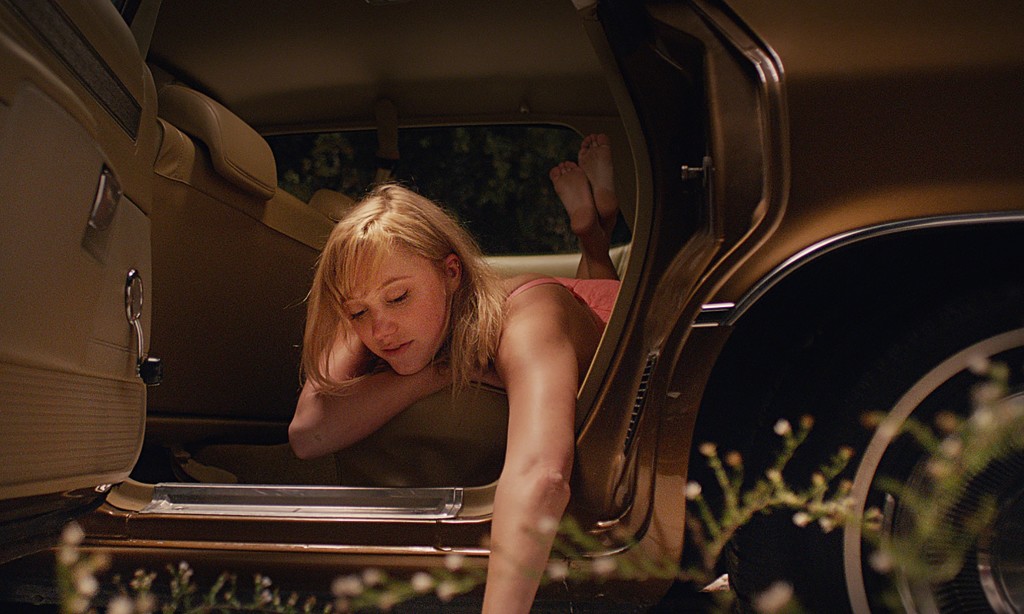
Jay, in the halcyon days before she’d ever heard of “it.”
Kelly, Paul, and Yara are busy playing cards on Kelly’s front porch when Hugh’s car rolls up, dumping her in her underpants on the curb, then drives off. (Hugh could have at least given her clothes back!) Greg and his mom see the police situation that unfolds across the street and wonder about Jay’s family. “Those people are such a mess,” his mom says. The police interview Jay to get her information about this consensual, but bizarre sexual encounter that, legally, they can do very little about. Jay is depressed for a few days later, spending much of her time in bed, inspecting her body in the bathroom mirror – she doesn’t look infected, but she feels it. During one of Jay’s college English classes (in which they’re studying “The Love Song of J. Alfred Prufrock“), an old woman slowly crosses the campus outside. As she begins to approach the window, Jay hastily leaves class. The old woman pursues her through the hallway and Jay runs to her car to drive away. Realizing that Hugh wasn’t just messing with her head, Jay finds her sister Kelly and friend Paul where they work at the local ice cream store to talk about her unusual condition.
In the ice cream stock room, the three young adults discuss whether what Hugh told Jay was real. Jay tells them about the old woman in her pyjamas, but Kelly is still convinced Hugh was lying. However, they make a plan to all sleep over at Jay’s, with Paul (who is obviously madly in love with Jay) staying downstairs on the couch as guard. During the sleepover, Jay has trouble sleeping, so visits Paul, watching B-movies downstairs. They reminisce about past sleepovers when they were much younger, and about the time the four of them found a stash of pornographic magazines, then brazenly read them while lounging on Greg’s front lawn, not realizing what they were doing. The window in the kitchen shatters and Paul runs to investigate. He returns to say the window has been broken, but whoever broke it must have fled. Paul leaves to find Kelly, and as soon as he does, Jay begins to hear a banging in the other room. Unwisely, she enters the kitchen to see a young woman, topless, only one sock on, who is peeing herself and creeping toward her. It’s following her again!
Jay races upstairs and locks herself in the bedroom. Kelly and Paul knock at the door, asking to be let in, assuring her there’s nothing outside. She lets them in and Jay begins to break down: “There’s something wrong with me.” Someone begins to try the doorknob of the bedroom, so Paul grabs a nearby broom as a weapon. Yara identifies herself from the other side of the door, but when they allow her in, a tall man walks in right behind her. (Clearly, only the infected can see the followers.) Jay screams and flees out the bedroom window. She descends from a ledge and takes her bicycle through the night, ending her journey in a creepy playground. Eventually, her friends find her on the swings in the darkened playground. Greg shows up, too, having overheard the broken window and ensuing ruckus across the street. Jay decides she needs to find Hugh and get some answers, so Greg offers to drive them.
The five arrive at a boarded-up house, apparently the address Hugh have Jay. Inside, they find homemade alarm systems of tin cans and a wealth of medications. In the attic, Paul and Jay find the mattress where he slept, along with a wealth of porno mags and balled-up Kleenex (which he didn’t even bother to throw away). Leafing through a copy of Playpen, Paul finds a photo of Hugh in his letterman jacket, which identifies him as a former student of Dawson High School. Someone there must know his real name! Jay and Greg speak to someone in the school’s office and return to the car with his real name: “Jeff.” They find his house fairly easily and have a very calm chat with him.
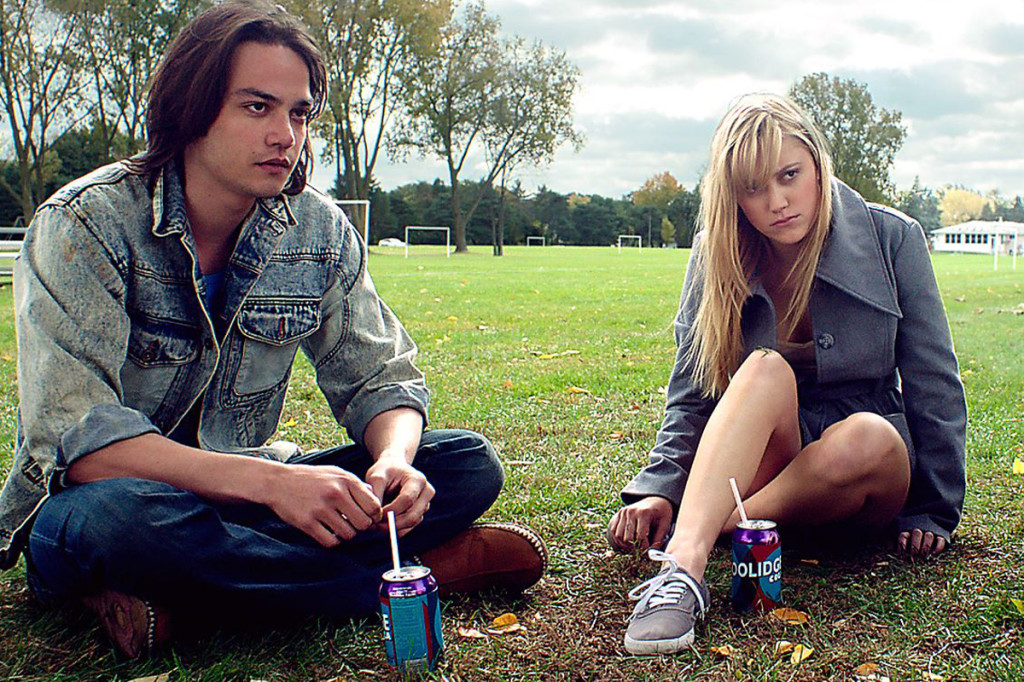
Greg and Jay enjoy a soda while discussing the unrelenting demon following her.
While they’re all seated on his lawn, Jeff (formerly Hugh) tries to detail further how to handle this thing that follows you – he says he got if from a one-night stand (he thinks), and the only way to be rid of it is to pass it along. “Should be easy for you,” he says. “You’re a girl.” How Hugh knows so much about this thing, despite not clearly knowing how he contracted it from, is beyond me. A soccer player walks up to their group and Jeff is spooked, but it turns out to be an actual person. He says that Jay and he shouldn’t be in such close proximity. Greg comes up with an idea: to stay at his family’s cottage, situated in a more remote area. As they drove out to the sticks, Marielle, Meg, and I devised various plans as to how we would attempt to forestall “it.” (See the Takeaway Points below for more on that.)
At the cottage, Greg finds his dad’s gun in the boathouse and they begin to practice with it. They have a morose beach party during which no one is entirely able to speak. Greg runs off to urinate while Yara lounges in the water in an innertube. But, strangely, Yara also appears to be walking towards them from the woods. Before any of them can realize what’s happening, they see Jay’s hair being pulled up into the air. Jay is then thrown to the ground. Paul picks up a beach chair and swings it at where the invisible assailant is, but the thing knocks him back. Jay, Kelly, Paul, and Yara run to the boathouse, pursued by the thing. Jay scrambles for the hidden gun. Paul, meanwhile, inspects his body where the thing touched him, and it’s covered in a hand-shaped bruise. As the thing approaches the doorway, Jay fires the gun, nearly shooting Greg in the distance, but then hits it square in the forehead. But the entity lifts itself up after a second and continues to follow. They lock the boathouse door.
The thing bangs at the door, eventually smashing a hole in the bottom. Greg yells at them from the outside, overly concerned about what they’ve done to the door. (He cannot see the thing causing the damage, naturally.) Jay crawls up to the hole to see if the coast is clear, but a redheaded boy leaps out and hisses at her. Jay runs out through the water exit of the boathouse, then finds Greg’s station wagon and speeds away from the cottage, leaving all her friends behind. She drives so recklessly, she doesn’t notice a truck reversing into the street, and has to swerve to avoid it, crashing in some farmer’s cornfield. When she awakes, she’s resting in a hospital bed with a head wound. Her friends are seated in the room beside her, all fast asleep. She waits there, helpless, listening to the nurses walk up and down the hospital halls, wondering if one of them is really “it.”
That night, in the hospital bed, Greg, true American hero, agrees to have sex with Jay to rid her of her demonic stalker. They solemnly make love, but Jay keeps her eyes on the door the entire time. (Paul, obviously, is super-jealous.) Three days later, Greg visits Jay in the hospital again to report that he hasn’t seen it – he doesn’t think it’s following him. (Such hubris!) Despite passing the affliction on, Jay still suffers from intense depression, hiding in her bedroom, refusing to open the door. Greg talks with Jay’s three friends, and they ask if he’s really never seen anything. “She didn’t make it up,” Paul insists. Greg, however, is dubious. That night, Jay stares out her window during her self-imposed sequestration. She sees Greg, in his undershirt and long underwear, walk down the block to his house, then attempt to open his own door. Failing, he resorts to throwing a rock through the window and climbing inside. Jay realizes that this may not be Greg at all!
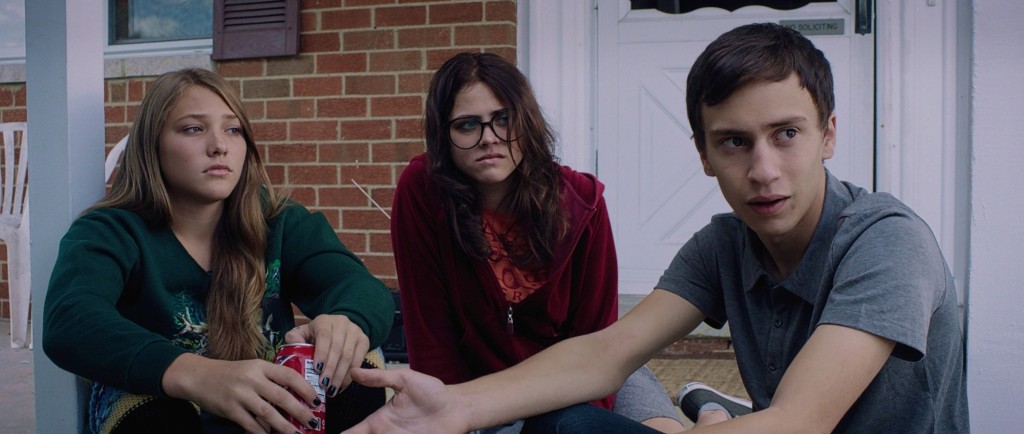
When the sweathog next door doesn’t believe you, it’s good your friends have your back.
She frantically calls Greg’s phone, but he doesn’t answer. So she runs across the street and climbs in through the broken window, as well. At the top of the stairs, she sees Greg’s mom, half-undressed, banging robotically at Greg’s door. Greg opens it and says, “What the fuck, Mom?” Moments after, his mom attacks him, pushing him back into the bedroom. Jay runs into the room and sees it (in the guise of Greg’s mom) seemingly “sexing” Greg to death. Electricity fires around the two of them and Greg is killed. Jay runs to her car and weepily drives away from her neighbourhood. She parks in a remote spot near the water and falls asleep on the hood of her car. (Meg asked, at this point, whether there was a rule that it couldn’t get you when you’re asleep, which is a very good question. It seems to need to have you aware of its presence to kill you.) When she awakes, she sees a leisure craft on the water, during which a few guys seem to be having an early morning boat party. She strips down to her underwear and enters the water, though viewers have no idea what happens next.
Later, Jay and Paul sit in her barricaded bedroom. Paul suggests that she could pass it on – to him, that is. Paul, clearly hurt that Jay decided to give Greg a death sentence instead of him, asks why she picked Greg. She notes that he didn’t seem scared, and she refuses to subject Paul to the same fate. Paul, looking around Jay’s room, spots a photo of her swimming and develops an idea. The four friends go to 8 Mile (a.k.a. Eminem’s home turf) and talk about how scared their parents were of their children ever visiting Detroit. (“That’s a weird class element to introduce,” Meg noted, given the movie was entering its final act.) They break into a massive university swimming pool, totally unattended but well maintained. They plug in an assemblage of electrical appliances and set them up poolside. Their plan is to lure it into the water, with Jay as bait, then dump in the devices to electrocute it.
Jay treads water for a while until her relentless pursuer arrives. He has taken the form (I think) of her father (who we’ve only seen in photographs to this point), and she begins to freak out. She points at the thing – invisible to everyone else – and says it’s just staring at her. Then it, unseen, doesn’t enter the water but instead begins tossing in the electrical equipment at Jay. He manages to wing Jay with a typewriter. Their plan is totally backfiring, but at least Jay doesn’t get electrocuted. Paul takes the gun and begins to fire at where the thing seems to be. Instead, he accidentally shoots Yara in the leg. Finally, Kelly – clearly the only one who’s ever seen an episode of Scooby-Doo – tosses a blanket over the entity, which provides Paul with a clear target. He shoots it in the back of the head and it falls into the pool.
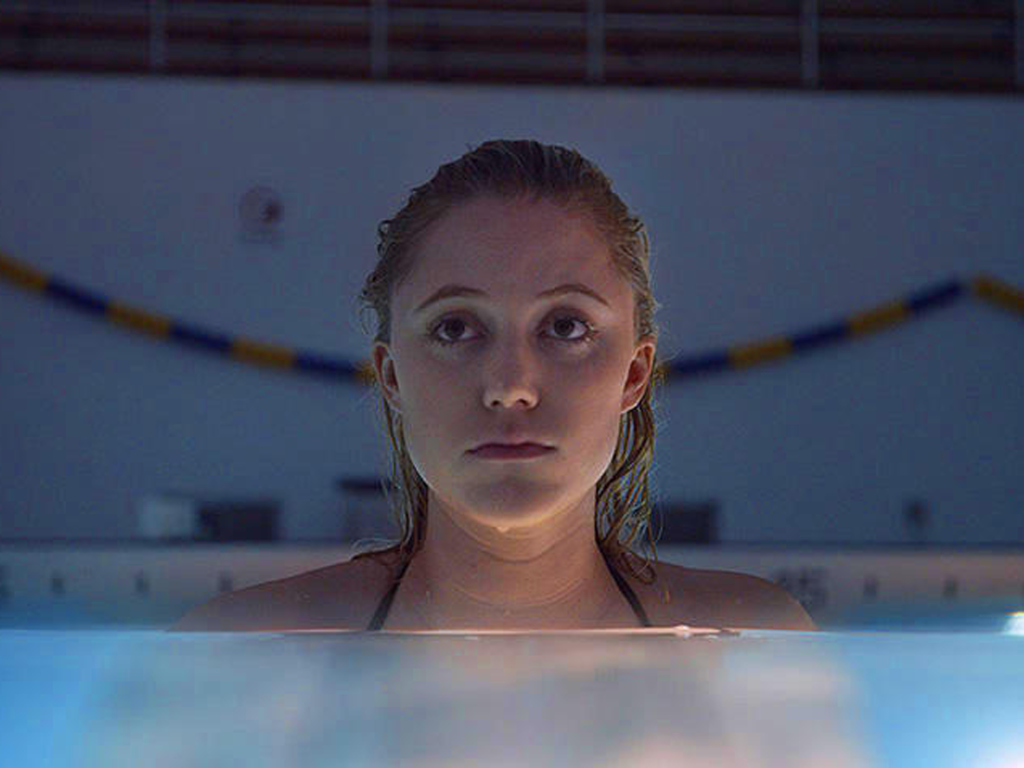
TFW you regret being bait for the murderous entity that’s taken the form of your estranged father.
Jay tries to swim out of the pool, but the thing isn’t dead. The creature that looks like her father swims after her and grabs her ankle. Paul begins to shoot wildly into the pool – who put him in charge of the gun? – finally hitting the thing in the head. It sinks to the pool’s bottom and Jay clambers out of the water. Her ankle is seriously bruised. Paul asks Jay if she can tell whether it’s dead. Jay cautiously crawls over to the pool, but only sees a massive amount of blood pooling and mushrooming in the water. On the rainy night that follows, Paul and Jay decide to have fairly grim sex. “Do you feel any different?” he asks her afterward. Neither of them do.
Paul is later seen driving past a couple of sex workers. The gang visits Yara, recuperating from her gunshot wound in the hospital, and she regales them – through a mouth full of sandwich – with a passage from The Idiot about the inevitability of death. Paul dozes in his chair, possibly exhausted by a bunch of sex-having. The final shot of the film shows Jay and Paul, walking hand-in-hand, down their street, with someone trailing behind who may or may not be following them.
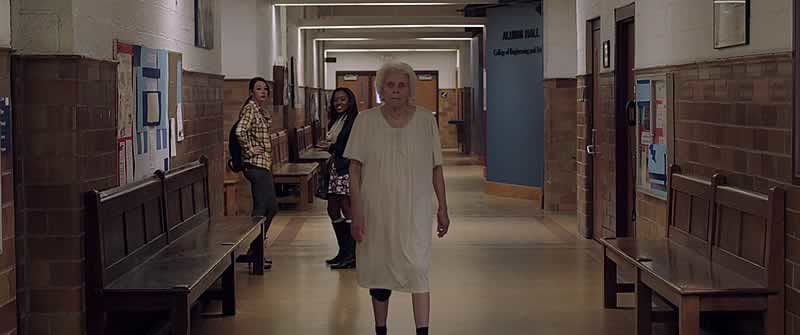
Someone should tell the mature student that university kids no longer show up to class in their pyjamas.
Takeaway points:
- It Follows, in which our characters sexually transmit an unstoppable pursuer who follows you until you die, is very obviously a metaphor for STIs, but also, of death in general. Much has been made of the STI parallels, and there’s no shortage of dread around sex in the movie. But the filmmakers – with their references to The Idiot and “J. Alfred Prufrock” – seem to be suggesting that “it” is more like death than an STI. Your really can’t avoid death. Even if you pass it along to someone else, it will eventually come back to you. Perhaps this is partially why It Follows is so scary – it’s a horror movie that is also our reality.
- Or is It Follows really a PSA about best practices regarding sex when you have an STI? Obviously, the meanest thing would be to have sex and pass this thing along without telling your partner. (In this case, your partner would die relatively soon, and the “STI” would come back to kill you in no time.) A better practice, the film seems to suggest, is to do as Hugh did – have sex with this STI, then inform your partner what has happened and what to expect. This allows him to live a bit longer – he is not punished as severely in this scenario. But he still tells Jay after the fact. The most humane practice would be to do as Jay and Paul do – go into it with the foreknowledge that you will be infected. In this case, they can both watch out for each other. As Marielle pointed out during the screening, there seems to be strength in numbers. Whether this is or isn’t a tacit endorsement of polyamorous relationships can’t be definitively proven.
- The big question of It Follows is: when does this take place? The vehicles look like they’re from the 1960s. The movies they watch are from the 1950s. The clothing they wear reads mostly as 1980s. But the compact e-reader Yara uses is clearly modern – even futuristic – and the girl from the opening calls her father on a mobile phone. It Follows consciously establishes its setting as outside of time, giving it a dream-like quality. You are not supposed to be able to identify the year.
- During a slower portion of the film, Marielle, Meg, and I devised our best practices for avoiding “it.” Suggestions included: having sex with someone relatively promiscuous just before they board an international flight, having sex with an astronaut just before he/she departs for space, having sex with a cheetah (?), attempting to trap it in a well, and possibly filling that well with concrete. But we are open to other suggestions.
- It Follows is yet another horror film that benefits greatly from a killer soundtrack. The score, composed and performed by Disasterpiece, is a collection of eerie and ominous electronic songs reminiscent of John Carpenter’s best work. It’s one of the best, most effective horror soundtracks in years.
- Perhaps the most clever part of It Follows is how it uses pre-established rules of pacing and framing from other horror movies to create its sense of dread. The camera is constantly either in slow-zoom or slow-pan, making viewers glance around the frame uneasily. In horror movies, when the cinematography takes on a certain feeling or pace, viewers know to be wary, for something unfortunate is about to happen. The genius of It Follows is that after Jay is infected, literally every scene is one of those scenes. Whenever Jay is conscious, we are on alert that something bad might happen, as is Jay herself. The nail-biting suspense can be almost too much to handle in some scenes.
- I have yet to parse what this means, but every thing that follows Jay is either completely naked or in some kind of sleepwear. Given that it also seems to be inactive while the victims are asleep, I feel like there’s a very distinct reason for this.
Truly terrifying or truly terrible?: It Follows is great. Just one of the best horror films made in the past decade. Not only is it high-concept, it’s incredibly creepy. You’ll feel paranoid for days afterward about anyone walking toward you at a certain pace. The very concept seems culled from a nightmare of our collective unconscious. It Follows also really exploits my personal fear of things happening at a distance. In horror movies, I find disturbing / scary things happening in close-up far less unsettling than things that happen at a bit of a distance to the camera. Thinking of scary moments – the bat-guy from Jeepers Creepers jumping into his truck, the filmmaker facing a corner in The Blair Witch Project, the cloaked lopper attacking the nurse in The Exorcist III – these all happen at some distance from the camera. It Follows is almost entirely scenes like that.
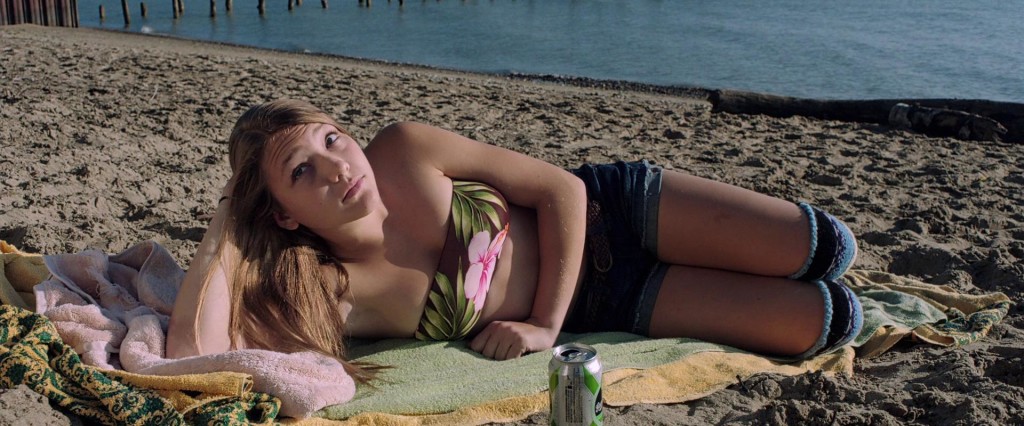
Legwarmers at the beach? Choose a style, Kelly! Just kidding; keep doing what you’re doing.
Best outfit: Who wears leg warmers to the beach? Jay’s sister Kelly does, along with a floral bikini top and jean shorts. It doesn’t seem like it would work together, and I’m not sure it does, but I certainly applaud the effort.
Best line: “Not Hugh?” – a perplexed Paul, upon learning Jay’s it-infected boyfriend’s real name is “Jeff”
Best kill: Not too many people die in It Follows. The post-murder scene of the film’s introduction is pretty striking, though – backward leg and all. So while the murder doesn’t happen on-screen, it manages to be the most memorable in it’s artistic, Hannibal-like aftermath.
Unexpected cameo: Paul is played by Keir Gilchrist, who may be known to many viewers as Marshall Gregson, Tara’s film-obsessed son on United States of Tara. When the entity takes the form of a very tall man who barges into Jay’s bedroom, he’s portrayed by Mike Lanier, a 7′ 7″ gentleman who also happens to be one of the world’s largest twins.
Unexpected lesson(s) learned: Despite their devastated economy, Detroit still manages to keep the lights on in their massive-yet-empty swimming complexes throughout the entire night.
Most suitable band name derived from the movie: Clamshell E-Reader
Next up: The Stepfather (1987).




